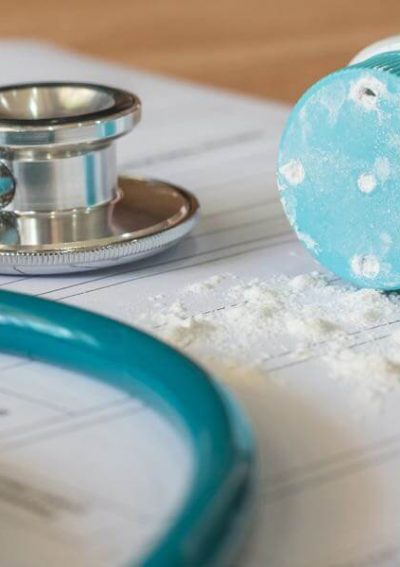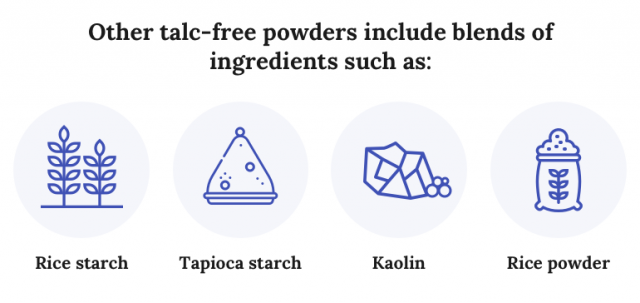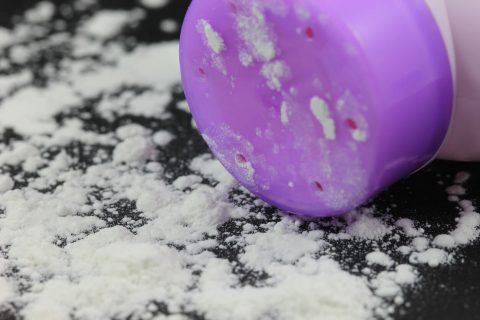Talcum Powder and Cancer
Decades of research suggest talcum powder use, especially near the vagina or through inhalation, may increase cancer risk. A 2024 report from the International Agency for Research on Cancer found talc exposure is likely linked to ovarian cancer and mesothelioma, sparking safety concerns.

Talcum Powder Dangers
Research suggests that using or being exposed to talcum powder may increase a person’s cancer risk. In fact, the International Agency for Research on Cancer (IARC) recently released a report stating that talc might cause cancer.
- Links between using talc and ovarian cancer in women
- Talc’s potential to harm human cells
- Possible asbestos contamination of talc
- Talc causing cancer in animals used for experiments
The IARC highlighted that people with ovaries who used talc in their genital area had a higher risk of developing ovarian cancer.
While many people understand the risks of using asbestos-contaminated talc, recent studies show that talc alone can be dangerous. For example, the IARC found that talc can cause long-term inflammation and affect human cells.
These findings are not surprising. Doctors and scientists have been raising concerns about potential links between talc and cancer for over 60 years.
In the late 1960s, researchers noted higher rates of mesothelioma among talc miners in New York. This rare cancer affects the lining of the lungs and other organs. Several studies since the late 1980s also suggest that using talc near the vagina may raise the risk of developing this deadly disease.
Links to Ovarian Cancer
There are different theories about how talcum powder use may raise ovarian cancer risk. Some scientists believe talcum powder migrates up the vaginal canal and causes cell inflammation. These inflamed cells eventually develop into cancer. Limited evidence also suggests inhaled talc particles could migrate from the lungs to the ovaries.
Others believe people with ovaries might be unknowingly using talcum powder that has asbestos in it. Asbestos is a mineral that can cause cancer.
Animal studies from the 1960s support the asbestos theory. In a 1967 study published in Environmental Research, researchers injected asbestos into guinea pigs’ abdomens. The reported changes in the animals’ ovaries were “similar to those seen in patients with early ovarian cancer.”
The researchers even noted that mesothelioma caused by asbestos resembles ovarian cancer.
Talc Products That May Pose an Ovarian Cancer Risk
- Baby powder
- Bath bombs
- Body wipes
- Body powder
- Bubble bath products
- Diaper and rash creams
- Genital deodorants and antiperspirants
However, one major supplier of talc products for babies, Johnson and Johnson, no longer sells talc-based baby powder. In August 2022, J&J announced it would stop selling its talc-based baby powder globally in 2023. The company said the decision is unrelated to any talcum powder safety issues or links to cancer.
Although J&J baby powder is now corn-starched-based rather than talc-based, other manufacturers may still use talc. Proceed with caution if you use talc products, especially in your genital area, or consider using a talc-free alternative.
Ovarian Cancer and Talc Product Lawsuits
In July 2018, a St. Louis jury awarded a $4.69 billion verdict to 22 women who developed ovarian cancer after decades of using Johnson’s & Johnson’s Baby Powder and other talc products for feminine hygiene purposes.

During the trial, lawyers interviewed expert witnesses. These experts found traces of asbestos and talc in the ovarian tissue removed from some of the women. This lends credence to the asbestos contamination theory.
In December 2018, Reuters revealed that Johnson & Johnson knew their talcum powder had asbestos. However, they chose not to inform the public. The report was based on internal company documents that came to light in talcum powder lawsuits.
Johnson & Johnson has called such news reports inaccurate. While it has changed the formula to a corn-starch base, the company still stands by its older talc-based baby powders.
“The decades-long record overwhelmingly shows that our talc is safe, and J&J has engaged with great transparency in open discussions on the safety of its talc with scientists and regulators, and we will continue to defend our position,” Johnson & Johnson said on its website.
Mesothelioma Connection
Talcum powder is linked to a rare and deadly cancer called mesothelioma. While mesothelioma can affect the linings of lungs, abdomen, heart and testicles, approximately 80% of cases involve the lungs.
Asbestos exposure is the leading cause of mesothelioma.
Studies suggest people can develop mesothelioma by inhaling or swallowing talcum powder containing asbestos. A 2014 study published in the International Journal of Occupational and Environmental Health says that using talcum powder in closed spaces may increase these inhalation risks.
The study was performed in conjunction with litigation. It looked at one brand of talcum powder used by 10 women who developed mesothelioma and found that the brand contained asbestos.
Scientists traced the asbestos in the talc back to the mines where the talc originated. They also found traces of asbestos in the lymph node and lung tissue of at least one of the women who developed mesothelioma.
Other Cancers
Researchers know less about talcum powder and its link to other cancers. However, some studies have shown possible risks for endometrial cancer.
A 2011 study in the journal Cancer Epidemiology, Biomarkers & Prevention found a small increased risk of endometrial cancer among postmenopausal people who used talcum powder on their genitals.
Researchers looked at the medical history of 66,028 women from the Nurses’ Health Study. This group included 599 women diagnosed with invasive endometrial cancer. It showed that postmenopausal women who used talc on their genitals had a 21% increased risk of endometrial cancer. Those who had used talcum powder more than once a week had a 24% increased risk of endometrial cancer.

Animal studies suggest a possible link between inhaling talcum powder and cancers like lung and adrenal gland cancer. The rate of lung cancer may also be higher among those who work in the talc industry. However, other contributing factors, like exposure to radon or smoking, should be considered. Radon is a naturally occurring radioactive gas that can accumulate in buildings.
Additional studies of cancers caused by talc are limited. Some research has examined a potential link between talc exposure and stomach cancer, but there is no strong evidence yet.
Minimizing Risks
If you’re worried about possible cancer risks associated with talcum powder, the best solution is to avoid using it. You could opt for a cornstarch-based powder instead. Although many consumer products have talc, alternatives include tapioca starch, baking soda, arrowroot powder and rice powder.

If you do use talcum powder, avoid inhaling it. People with ovaries should avoid using it in their genital area. Also, try to use the smallest amount of talcum powder possible.
If you’re concerned that you may have a health issue related to talc exposure, talk to your doctor.
Editor Lindsay Donaldson contributed to this article.
34 Cited Research Articles
Consumernotice.org adheres to the highest ethical standards for content production and references only credible sources of information, including government reports, interviews with experts, highly regarded nonprofit organizations, peer-reviewed journals, court records and academic organizations. You can learn more about our dedication to relevance, accuracy and transparency by reading our editorial policy.
- Whitmer, M. (2025, January 15). Talcum Powder and Asbestos. Retrieved from https://www.asbestos.com/products/talcum-powder/
- Marchese, S. (2024, December 9). Mesothelioma Statistics. Retrieved from https://www.asbestos.com/mesothelioma/statistics/
- American Cancer Society. (2024, August 1). Talcum Powder and Cancer. Retrieved from https://www.cancer.org/cancer/risk-prevention/chemicals/talcum-powder-and-cancer.html
- Stayner, L.T., et al. (2024, August). Carcinogenicity of Talc and Acrylonitrile. Retrieved from https://www.thelancet.com/journals/lanonc/article/PIIS1470-2045(24)00384-X/abstract
- Clinica Barcelona. (2024, July 5). Is Talcum Powder a Risk Factor for Ovarian Cancer? Retrieved from https://www.clinicbarcelona.org/en/news/is-talcum-powder-a-risk-factor-for-ovarian-cancer
- International Agency for Research on Cancer. (2024, July 5). IARC Monographs Evaluate the Carcinogenicity of Talc and Acrylonitrile; IARC Monographs Volume 136. Retrieved from https://www.iarc.who.int/wp-content/uploads/2024/07/pr352_E.pdf
- O’Brien, K.M., et al. (2024, May 15). Intimate Care Products and Incidence of Hormone-Related Cancers: A Quantitative Bias Analysis. Retrieved from https://ascopubs.org/doi/abs/10.1200/JCO.23.02037?journalCode=jco
- Anja. (2023, September 13). Why Talc-Free Baby Powders Are Better: Top Alternatives You Need to Know About. Retrieved from https://www.anjahealth.com/blog/best-alternatives-to-talc-baby-powder
- Johnson & Johnson. (2022, August 11). Johnson & Johnson Consumer Health to Transition Global Baby Powder Portfolio to Cornstarch. Retrieved from https://www.jnj.com/johnson-johnson-consumer-health-to-transition-global-baby-powder-portfolio-to-cornstarch
- Reuters. (2022, August 11). J&J to stop selling talc-based baby powder globally in 2023. Retrieved from https://www.cnbc.com/2022/08/11/jj-to-stop-selling-talc-based-baby-powder-globally-in-2023.html
- Zuckerman, D. & Shapiro, D. (2021). Talcum Powder and Ovarian Cancer. Retrieved from http://www.center4research.org/talcum-powder-ovarian-cancer/
- American Cancer Society. (2019, January 8). Key Statistics for Ovarian Cancer. Retrieved from https://www.cancer.org/cancer/ovarian-cancer/about/key-statistics.html
- Johnson & Johnson. (2018, December 15). Johnson & Johnson Statement on December 15 the New York Times Article. Retrieved from https://www.jnj.com/our-company/johnson-johnson-issues-statement-on-december-15-following-the-new-york-times-article
- Government of Canada. (2018, December 13). Talc: Learn About Talc and if It’s Safe. Retrieved from https://www.canada.ca/en/health-canada/services/chemicals-product-safety/talc.html
- Bostock, B. (2018, December 6). Canada Warns Talcum Powder Poses a Risk of Ovarian Cancer After $4.69 Billion Product Defect Case. Retrieved from https://www.businessinsider.com/canadia-talcum-powder-poses-risk-of-ovarian-cancer-fibrosis-2018-12
- American Cancer Society. (2018, December 3). Talcum Powder and Cancer. Retrieved from https://www.cancer.org/cancer/cancer-causes/talcum-powder-and-cancer.html
- Dyer, Owen. (2018, December 28). Johnson & Johnson knew for decades talcum powder contained asbestos, reports allege. Retrieved from https://www.bmj.com/content/363/bmj.k5430
- Johnson & Johnson. (2018, December 16). Johnson & Johnson Responds To Recent News Coverage on Talc. Retrieved from https://www.jnj.com/our-company/johnson-johnson-responds-to-recent-news-coverage-on-talc
- Girion, L. (2018, December 14). Powder Keg: Johnson & Johnson Knew for Decades That Asbestos Lurked in Its Baby Powder. Retrieved from https://www.reuters.com/investigates/special-report/johnsonandjohnson-cancer/
- Ubelacker, S. (2018, December 5). Talcum Powder Could Pose Danger to Lungs and Ovaries, Health Canada Warns. Retrieved from https://www.cbc.ca/news/health/talcum-powder-may-be-harmful-to-lungs-health-canada-1.4933506
- McGinley, L. (2017, August 28). Does Talcum Powder Cause Ovarian Cancer? Retrieved from https://www.chicagotribune.com/lifestyles/health/ct-baby-talcum-powder-ovarian-cancer-20170828-story.html
- Christensen, J. (2018, July 13). $4.69 Billion Verdict Against Johnson & Johnson’s Talcum Powder. Retrieved from https://www.cnn.com/2018/07/13/health/4-69-billion-verdict-johnson--johnson-talcum-powder/index.html
- The Associated Press. (2017, May 5). Woman Awarded Record $110M in Baby Powder Lawsuit. Retrieved from https://www.thestar.com/business/2017/05/05/woman-awarded-record-110m-in-baby-powder-lawsuit.html
- Cramer, D.W. et al. (2016, May). The Association Between Talc Use and Ovarian Cancer: A Retrospective Case-Control Study in Two U.S. States. Retrieved from https://journals.lww.com/epidem/Fulltext/2016/05000/The_Association_Between_Talc_Use_and_Ovarian.6.aspx
- Steenhuysen, J. (2016, February 26). Evidence on Talc Cancer Risk Differs for Jurors, Researchers. Retrieved from https://www.scientificamerican.com/article/evidence-on-talc-cancer-risk-differs-for-jurors-researchers/
- Gordon, R.E., Fitzgerald, S. & Millette, J. (2014, October). Asbestos in Commercial Cosmetic Talcum Powder as a Cause of Mesothelioma in Women. Retrieved from https://www.ncbi.nlm.nih.gov/pubmed/25185462
- Muscat, J.E. & Huncharek, M.S. (2013, April 9). Perineal Talc Use and Ovarian Cancer: A Critical Review. Retrieved from https://www.ncbi.nlm.nih.gov/pmc/articles/PMC3621109/
- Karageorgi, S. et al. (2011, May 1). Perineal Use of Talcum Powder and Endometrial Cancer Risk. Retrieved from https://www.ncbi.nlm.nih.gov/pmc/articles/PMC2866017/
- Langseth, H. et al. (2008, March 13). Perineal Use of Talc and Risk of Ovarian Cancer. Retrieved from https://jech.bmj.com/content/62/4/358.info
- Hull, M.J., Abraham, J.L. & Case, B.W. (2002, December 1). Mesothelioma Among Workers in Asbestiform Fiber-Bearing Talc Mines in New York State. Retrieved from https://academic.oup.com/annweh/article/46/suppl_1/132/317491
- National Toxicology Program. (1993, September). Toxicology and Carcinogenesis Studies of Talc (Cas No. 14807-96-6) in F344/N Rats and b6c3f, Mice (Inhalation Studies). Retrieved from https://ntp.niehs.nih.gov/ntp/htdocs/lt_rpts/tr421.pdf
- Graham, J. & Graham, R. (1967, October). Ovarian Cancer and Asbestos. Retrieved from https://www.sciencedirect.com/science/article/pii/0013935167900084
- Kleinfeld, M. et al. (1967, January 10). Mortality Among Talc Miners and Millers in New York State. Retrieved from https://www.tandfonline.com/doi/abs/10.1080/00039896.1967.10664815
- Yale Medicine. (n.d.). Mesothelioma. Retrieved from https://www.yalemedicine.org/conditions/mesothelioma
Calling this number connects you with a Consumer Notice, LLC representative. We will direct you to one of our trusted legal partners for a free case review.
Consumer Notice, LLC's trusted legal partners support the organization's mission to keep people safe from dangerous drugs and medical devices. For more information, visit our partners page.
855-613-6647



